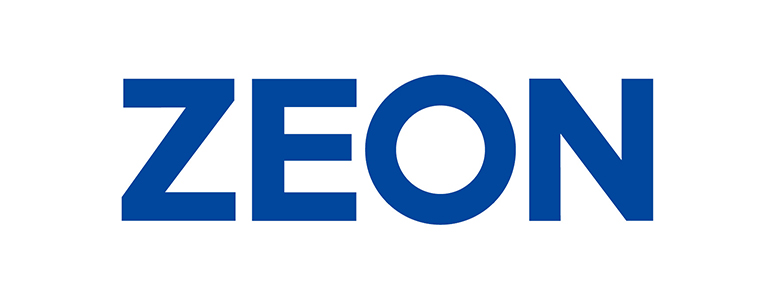| ZEON CORPORATION (4205) |
|
||||||||
Company |
ZEON CORPORATION |
||
Code No. |
4205 |
||
Exchange |
TSE 1st Section |
||
Industry |
Chemicals |
||
President |
Kimiaki Tanaka |
||
HQ Address |
Marunouchi 1-6-2, Chiyoda-ku, Tokyo |
||
Year-end |
March |
||
URL |
|||
* Share price as of closing on June 29, 2017. Number of shares outstanding as of most recent quarter end and does not include treasury shares. ROE and BPS are from the last year-end.
|
||||||||||||||||||||||||
|
|
* Estimates are those of the Company. Net income is net income attributed to parent shareholders.
|
| Key Points |
 |
| Company Overview |
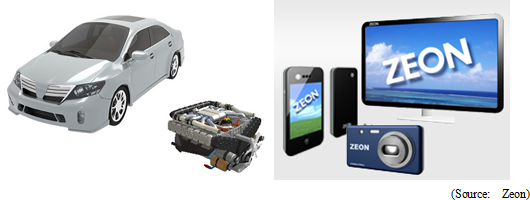 (Company Name and Management Vision)
The company name "Zeon" is derived from the Greek word for earth "geo" (phonetically pronounced "zeo" in Japanese) and the English word reflecting eternity "eon," and reflects the Company's principle of "deriving raw materials from the earth and perpetually contributing to human prosperity" through the development and application of creative technologies. (Zeon's original name "Geon," used at the time of its establishment, was derived from the trademark acquired for the vinyl chloride resin "Geon" from the Goodrich Corporation (then called B.F. Goodrich Company) in the United States, with which it had capital and collaborative technological agreements. The company name was changed to "Zeon" when the capital agreement was dissolved in 1970.)
(Corporate History)
Zeon was established as a joint venture company formed by the Furukawa Group of companies: Nippon Light Metal Co., Ltd., Furukawa Electric Co., Ltd., and Yokohama Rubber Co., Ltd. in April 1950 to acquire and use the vinyl chloride resin technology from B.F. Goodrich Chemicals Co. In 1951, Goodrich acquired 35% of the shares of Zeon for full-scale technological and capital partnership, and in 1952 mass production of vinyl chloride resin began in Japan for the first time. In 1959, Goodrich transferred synthetic rubber manufacturing technologies to Zeon, which, in turn, started Japan's first mass production of synthetic rubber. Manufacturing facilities were also expanded to match the growing demand for tires and other automobile parts. In 1965, use of the Company's unique technology called Geon Process of Butadiene (GPB) for the efficient manufacture of butadiene (main raw material of synthetic rubber) from C4 fraction was operational.Goodrich transferred its specialty synthetic rubber business to Zeon along with the shift in its main business focus toward vinyl chloride resins. Capital ties were dissolved in 1970. Along with these changes, the Company name was changed from Geon to Zeon in 1971. Also in 1971, Zeon developed a unique technology called Geon Process of Isoprene (GPI) and began using it to manufacture raw materials including high-purity isoprene, hydrocarbon resins, and synthetic perfume ingredients from C5 fraction. After entering the 1980s, Zeon aggressively launched new businesses in various fields including photoresists and other information materials, and medical-related applications in addition to its main synthetic rubber business. In 1984, production of hydrogenated nitrile rubber Zetpol®, which currently has top share of the worldwide market, began at the Takaoka Plant. In 1990, manufacture of synthetic cyclo-olefin polymer resin (COP) ZEONEX®, which is the main product of the specialty material business using the GPI method to extract and synthesize products, was started at the Mizushima Plant. In 1993, Zeon entered China with its electronics materials business. In 1999, Zeon Chemicals L.P. (Consolidated subsidiary in the United States) acquired the special rubber business of Goodyear Tire & Rubber Company of the United States to become the world's top manufacturer of specialty rubber. In 2000, Zeon discontinued production of vinyl chloride resins at the Mizushima Plant, and thus withdrew from the Company's founding business. In 2002, ZeonorFilmTM was launched as a liquid crystal display (LCD) use optical film. Zeon Chemical Singapore Pte. Ltd. and Zeon Korea Co., Ltd. were founded, in 2010 and 2011 respectively, as part of the strategy to fortify Zeon's global production and sales structure. In March 2013, a takeover bid of TOHPE CORPORATION was completed and Tohpe became a fully owned subsidiary. In September 2013, the plant for S-SBR in Singapore was completed and started commercial operation from April 2014. In February 2015, Zeon enhanced capacity of optical film for LCD in Himi City, Toyama prefecture. In November 2015, Zeon started the world's first mass production of "super growth carbon nanotube". In April 2016, the second series is in operation at S-SBR production base in Singapore. (Business Description)
Zeon's main products use various extracted from naphtha, which is extracted by distillation of crude oil. Zeon uses butadiene extracted in the GPB method developed in-house from C4 fraction after extracting propylene (C3), isoprene monomer (IPM) extracted from C5 fraction using the GPI method, high-boil monomer (HB), dicyclopentadiene (DCPD), and 2-butyne as raw materials to be processed into synthetic rubber, synthetic latex and various other materials. 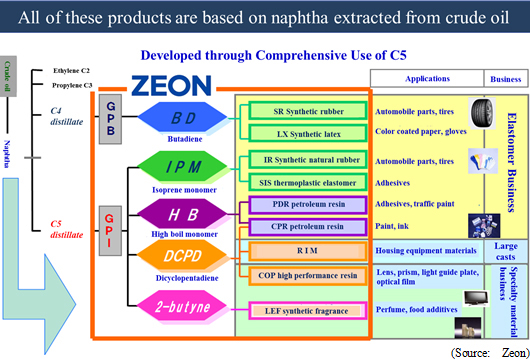  <Elastomer Business>
Elastomers are "high molecular compounds that have rubber-like elastic properties," an example of which is synthetic rubber. As described in the corporate history section of this report, in 1959 Zeon became the first company in Japan to mass-produce synthetic rubber, which became the foundation underlying all of Zeon's businesses. This business includes the segments of synthetic rubber, synthetic latex, and chemical products (hydrocarbon resins, thermoplastic resins) businesses.
①Synthetic Rubber Business
<Example of final product : Tires>Zeon provides the world's leading tire manufacturers with the world's highest-quality synthetic rubber for use in tires. Among the various types of synthetic rubber manufactured are styrene butadiene rubber (SBR), which promotes superior abrasion resistance, aging resistance and mechanical strength properties, butadiene rubber (BR), which includes a superior balance between elasticity, wear and low-temperature properties, and isoprene rubber (IR), which features similar high levels of quality, consistency and other properties as natural rubber. Zeon expects the demand for S-SBR for low fuel consumption tires, which further improved the characteristics of SBR, to expand rapidly in the future. In order to increase the supply capacity corresponding to this, Singapore plant started operation in September 2013 (the first line). The second line started operation in April 2016. The supply capacity of the Singapore plant is 70,000 tons. 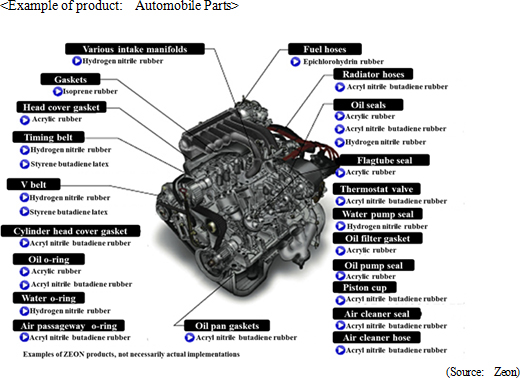 Furthermore, a new grade of Zetpol® has vastly improved the performance of products using the original versions of Zetpol®. Products using the new grade of Zetpol® are heat resistant at temperatures that exceed the limits for the original version of Zetpol® by 15 degrees centigrade, thereby extending the life of seals and gaskets, and are in strong demand for use in next generation bio-fuel engines. The new grade of Zetpol® is well suited to extrusion processing which is being leveraged to expand its usage in various hoses. Products using Zetpol® have also been well received by customers, and are being used increasingly as a replacement material for more expensive competitive rubber in Japan, Asia, Europe and North America. Commercial production of the new Zetpol® started in November 2012 at Zeon's Kawasaki Plant and reached full-scale production in 2013. ②Synthetic Latex Business
Synthetic latex is liquid rubber that synthetic rubber dispersed in water. It is used to manufacture gloves, paper coating, textile processing, adhesives, paints, and cosmetic puffs, etc. Zeon has close to 90% share of NBR latex used in cosmetic puffs.
③Chemical Products Business
Zeon produces C5 fraction by its unique in-house GPI method, and turn it into materials for adhesive tapes and hot melt adhesive, traffic paint binder and a wide variety of other products.
<Specialty Material Business>
①Information Materials
Zeon deals in high value added materials and parts that are created using its unique technologies including polymer design and processing technologies.Cyclo-olefin polymer extracted and synthesized from C5 distillate using GPI methods are thermoplastic plastics developed using Zeon's own unique technologies and are used to make the commercial products ZEONEX® and ZEONOR®. ZEONEX® leverages its high transparency, low water absorption and low absorptive properties for use in camera and projector lenses and other optical applications, and in medical use containers including syringes and vials. ZEONOR® leverages its high transparency, transferability, and heat resistance properties for use as transparent general use engineering plastics used in light guide plates, automobile parts, containers, discs and a wide range of other product applications. ZeonorFilm® is the world's first optical film by the melt extrusion method from the cyclo-olefin polymer. It is excellent in optical properties, low water absorption / low moisture permeability, high heat resistance, low outgassing and dimensional stability. Not only for displays for LCD TV, smartphones and tablets, is it expected to be used in a wide range of applications such as digital signage in the future. 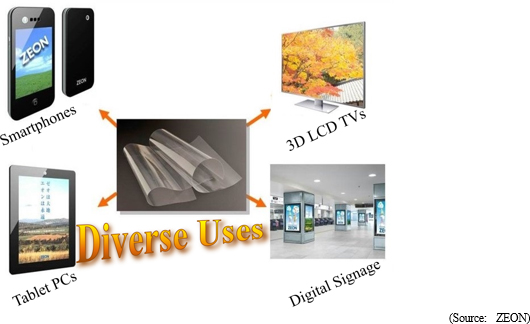 The OELD application as anti-reflection film is progressing, and demand for small- to medium-sized flat panel display applications is growing. In addition to the current plants in Takaoka and Himi (an annual output of 15 million square meters for optical film in total), the construction of a new plant in Tsuruga, Fukui Prefecture was completed in October 2013. ZEOCOAT® is organic insulation material used in cellphones, smartphones, and LCD televisions. ZEOCOAT® was successful in improving both the picture quality and reliability of displays because of its high transparency, extremely low water absorption and low gas generation properties. Zeon will aggressively expand its marketing efforts for OELDs, which will be thinner displays than LCD, thin-film transistors using new semiconductors, and flexible displays. ②Energy Materials
Zeon provides materials for lithium ion battery in this segment; anode / cathode binders, binder for functional layer (heat resistant separator), and sealant. Currently, Li-ion batteries are widely used as a power source for mobile devices such as mobile phones and notebook computers. Due to the rapid popularization of smartphones, there is a strong demand for higher capacity batteries. Adoption for industrial power sources (such as electric vehicles, including hybrid and plug-in hybrid cars, and smart grids, etc.) also have begun, since it is lightweight, compact and can store a lot of energy. On the other hand, there was a problem that lifetime tends to decrease under high temperature usage. The company has advanced the function of Li-ion battery binder and succeeded to develop an aqueous cathode binder, which greatly contributes to longer battery life. In addition, Zeon succeeded in commercializing anode binder, which can raise the storage capacity of Li-ion battery by 5% to 15%. Zeon believes that its materials contribute to safety, long life and battery capacity increase of Li-ion batteries and contribute to the widespread of hybrid cars. The company focused on the promising future of Li-ion batteries and worked on it for a long time. In this business segment for 2020, Zeon seeks to keep its top share in the Li-ion battery binder market, aims to expand the diffusion of new material functions that meet the needs of the application and propose functional materials to realize the next generation of new batteries. 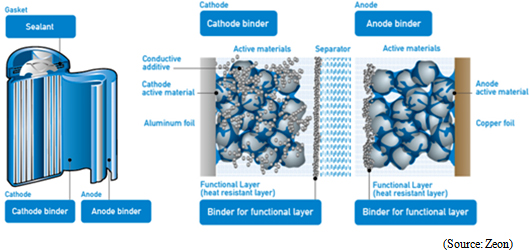 ③Medical Device
The medical device market is relatively well insulated from fluctuations in the economy, and is anticipated to grow with the aging society in Japan and expansion in developing countries. Furthermore, medical device companies are subject to strict laws and regulations, and they need to submit approval applications to regulatory bodies. In addition, the need to develop relationships with healthcare professionals is critical and the subsequent high barriers to entry makes this a highly attractive market.Along with the start of development of artificial kidneys in 1974, Zeon aggressively promoted its medical device business. In 1989, a subsidiary Zeon Medical Inc. was established to conduct development, manufacturing, sales and all other functions of the medical field for the Zeon Group. Zeon has shown bountiful development track record both in gastroenterology and cardiovascular area. The Offset Balloon Catheter as a means of differentiation in the gallstone removal process and with Japan's first biliary covered stent Zeostent Covered in the area of gastroenterology products, and the world's smallest diameter XEMEX IABP Balloon PLUS as a device to aid the heartbeat at times of acute myocardial infarction in the area of cardiovascular products. 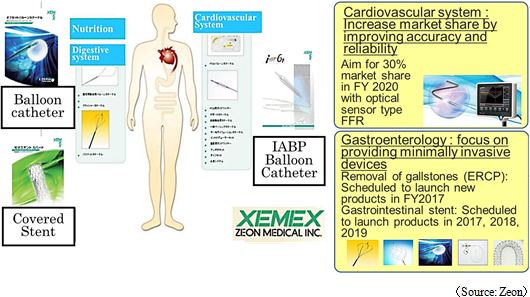 In March 2016, the Company launched the world's first optical sensor FFR device as a type of guide wire. Because it uses an optical fiber sensor, mistaken readings of blood pressure measurements rarely occur. The operability as a guide wire has also gained a high evaluation and Zeon is aiming for a 30% share of the Japanese market by 2020. ④Chemical Products Business
Zeon deals in specialty chemicals that use ingredients derived from C5 fraction, such as synthesized fragrances for cosmetics and flavor used in foods, solvents and plant growth regulator. The Company holds the world's top share of the synthesized fragrances in green note. They provide a wide range of specialty products including ingredients for intermediary bodies used in medical and agricultural chemicals, alternative CFCs solvents, cleaning agents, urethane expanding agent, and functional ether agents.
①What is Single-Walled CNT?
Carbon Nanotubes (CNTs) are cylindrical nanostructure formed by hexagonal lattice of carbon atoms. In 1993, Sumio Iijima, Ph.D., head of the Applied Nanotube Research Center of the National Institute of Advanced Industrial Science and Technology (AIST), discovered this structure for the first time in the world and named Carbon Nanotubes (CNTs). CNTs are categorized into single-walled and multiple-walled CNTs. Multiple-walled CNT is relatively easy to manufacture and the developments for commercial applications already started.
 - 20 times stronger than steel - 10 times more heat conductive than copper - Half as dense as aluminum - 10 times the electron mobility of silicon - lightweight but highly flexible - has extremely high electric-and heat-conductivity properties Possible CNT applications are electrical conductivity assistance agent in Li-ion batteries, transparent conductive film used in electronic paper and ultra-thin touch panel because of its high elasticity and strength, and as a heat dissipating material. Because of its ability to absorb a wide spectrum of light, practical applications of single-walled CNT are being promoted in the area of electromagnetic wave absorbing materials for use in a wide range of fields including energy, electronics, structural materials, and specialty materials.  ②Zeon's Efforts and Position
Against this backdrop, the AIST and five companies* jointly established the technological consortium Technology Research Association for Single-Walled Carbon Nanotubes in May 2010 (*Zeon, NEC Corporation, Toray Industries, Teijin Limited, and Sumitomo Precision Products Co., Ltd.). The consortium aims at establishing technologies that are necessary for the commercialization of new products using single-walled CNT developed in Japan with its numerous superior qualities in response to the worldwide social demands to realize a low-carbon society. Using the synthesizing technology super growth method developed by Dr. Kenji Hata (Ph.D.) of the AIST as a base, the above-mentioned consortium has been conducting research and development for mass production and application development for compound materials at a validation plant that was established in December 2010 on the premises of the Tsukuba Center of the AIST. Among the main reasons that the AIST Nanotube Application Research Center selected Zeon to become its partner were the impressive track record and results obtained by Kohei Arakawa, Zeon's former Managing Director, as a researcher in CNT research and development. Furthermore, the fact that the consortium director is Zeon President Furukawa reflects the importance of Zeon in this project to realize commercial applications of single-walled CNT. ③Future Endeavors
Having established the mass production technology based on the super growth method, Zeon completed the CNT production facility and started mass production, the first in the world in November 2015 in its Tokuyama plant at Shunan-city, Yamaguchi Prefecture.Zeon is the only company in the world that has established mass production technologies for single-wall CNT. In addition to those companies within the consortium mentioned above, about 100 Japanese and foreign companies request for its product samples. Consequently, shipments of samples have already begun. Zeon has also begun to propose practical applications of this product. At the same time, single-wall CNT is a type of nanomaterial that is extremely small and fiber shape . Therefore, there is a concern that it may have some impact upon biological processes depending upon its size and shape. Currently, the AIST is conducting standardization of the evaluation process, and activities for the OECD endpoint measurement are being conducted, with global standardization and legal and regulatory aspects being considered. <Other Business>
The combination liquid for Reaction Injection Molding (RIM) and molded items using the ingredient dicyclopentadiene (DCPD) as a raw material.
(Characteristics and Strengths)
1. World's Leading Creative Technology Development Capability
The GPB method used to manufacture butadiene from C4 fraction is the most important development in Japan's postwar history of chemicals, and is licensed to 49 plants in 19 countries around the world.In addition, the Mizushima Plant is the world's only plant with GPI method to extract high-purity isoprene and other effective substances from C5 fraction. This Zeon's GPI method is a completely unique technology, which is not provided to other companies. Zeon is able to acquire basic ingredients used in synthesized fragrances and hydrocarbon resin. These two technologies represent the creative technological capabilities that are among the strengths of Zeon. They also are highly regarded and have received numerous awards in the global markets. With regard to technologies, Zeon has received 48 awards since 1960 including the GPB and GPI methods, in addition to 26 awards since 1982 for its environment conservation and safety efforts. 2. High Worldwide Share
Zetpol®, ZEONEX®, and ZEONOR® are representative of the products born from Zeon's highly creative technologies, which have allowed it to acquire high shares of worldwide markets. In addition, their Leaf alcohol for in cosmetics and food flavorings and NBR latex for cosmetic puffs have the world's top share.
3. Research and Development Structure that Continues to Yield Creative Technologies
Zeon seeks to conduct research and development activities based upon its basic corporate philosophy of "developing creative technologies in special fields of strength that enables Zeon to contribute to society by generating the world's leading businesses."The Company's main R&D center is located in Kawasaki City, Kanagawa Prefecture. Zeon has also established the Precision Optics Laboratory and Medical Laboratory at the Takaoka Plant, and the Chemical Product Research Facility at the Yonezawa Plant for more efficient research and development activities to be conducted closer to the manufacturing sites. The research groups are also in the United States. The R&D personnel are never satisfied with the current conditions, and always keep conscious of the threat that their competitors pose in their research activities. Furthermore, Zeon bases its valuation on a positive point awarding system that places high priority -on speed and creativity. R&D expenses were formerly measured as a percentage of sales, but now it has established an annual value amount of ¥12.0 ~ ¥13.0 billion as an investment budget to ensure that stable R&D activities can be maintained in the future. |
| Fiscal Year March 2017 Earnings Results |
 Higher Volumes, Lower Prices, Stronger Yen Cause Sales to Fall, Profits to Rise
Sales declined by ¥8.0 billion year-on-year to ¥287.6 billion during fiscal year March 2017. While increases in sales of optical film for television applications and battery materials contributed an additional ¥8.0 billion to sales, deterioration in overseas market pricing and declines in pricing of elastomer products, and foreign exchange related factors led to sales losses of ¥6.6 and ¥9.4 billion respectively. Operating income rose by ¥0.9 to ¥30.7 billion. Pricing declines and foreign exchange depressed profits by ¥6.6 and ¥9.4 billion respectively, but lower raw material costs and economies of scale boosted profits by ¥10.6 and ¥5.1 billion respectively. Ordinary income declined by ¥0.3 to ¥31.8 billion. Foreign exchange related loss expanded to ¥0.9 billion. Net income rose by ¥5.1 to ¥23.2 billion due in part to a reduction in loss from liquidation of affiliated companies to ¥0.5 billion in the current term from ¥3.6 billion in the previous term. 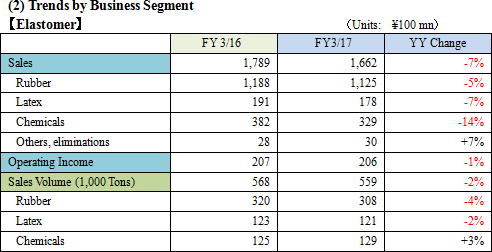 Sales volumes of rubber materials fell by 4%, and general use rubber used in tires fell by 2% year-on-year respectively. Sales within Japan decline by 9% due to the Japanese tire manufacturers' capacity utilization rates decline. Export sales rise by 4% by the strong demand for S-SBR and a recovery in market conditions after the start of the fourth quarter. Specialty rubber declined by 6% year-on-year. Sales within Japan rose by 5%, but worsening market conditions caused overseas sales to decline by 11%. The sales composition of specialty rubber in terms of volume and value declined by 1% and 4% points to 30% and 54% respectively. Latex saw a 2% decline in volumes. Sales volumes of resin modifier applications declined due to utilization rate conditions of customers. Chemical products saw a 3% increase in sales volumes, but sales value fell on the back of worsening overseas market conditions and strengthening in the Japanese yen.  The increase in sales of Specialty Chemicals section is attributed to a 1% year-on-year increase in electronic materials and a strong 38% in battery material exports. Chemical products sales rose by 3%, but toner sales declined by 3% due to the "paperless" trend. Within the specialty plastics business, optical film sales rose by 8% year-on-year, but COP resin sales fell by 8% year-on-year. Sales volumes of optical films for television applications rose by 21% year-on-year. Inventory adjustments for small to medium sized applications contributed to a large decline in sales composition from 37% in the previous term to 18% in the current term.   An additional ¥0.8 billion in sales were derived from higher sales volumes, and ¥4.0 and ¥1.8 billion from pricing factors and foreign exchange respectively. The sales decline in specialty material business is attributed to declines in sales volumes of optical film for television applications. Higher cost of sales and lower sales volumes negatively influenced operating income to the tune of ¥3.6 and ¥0.9 billion respectively. At the same time, pricing and foreign exchange positively influenced operating income to the tune of ¥4.0 and ¥1.8 billion. 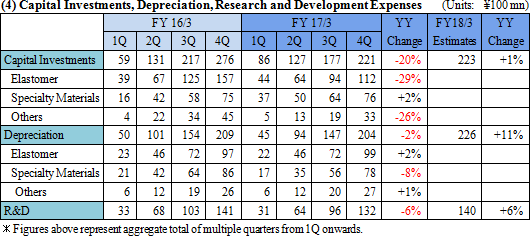  While payables increased, declines in long term interest bearing liabilities amounting to ¥11.8 billion caused total liabilities to fall by ¥2.3 billion. Declines in foreign exchange adjustment accounts due to the stronger yen, increases in shareholders' equity due to increases in retainer earnings, and an increase in other marketable securities valuation gains contributed to a ¥29.0 billion increase in net assets. Consequent to these developments, capital adequacy ratio fell by 3.6% points from the end of the previous term to 58.4% at the end of the current term.  Despite acquisition of tangible assets, the margin of outflow of investing cash flow contracted by ¥5.7 to ¥29.1 billion. The margin of net inflow of free cash flow grew by ¥7.1 to ¥19.9 billion. Acquisition of treasury stock declined but reduction in interest bearing liabilities caused the net outflow of financing cash flow to expand by ¥6.8 to ¥15.8 billion. At the same time, cash position rose. |
| Fiscal Year March 2018 Earnings Estimates |
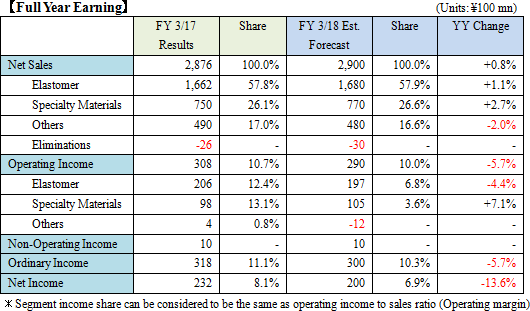  Sales to Rise, Profits to Fall
Zeon's earnings estimates call for sales to rise by 0.8% or ¥2.4 billion year-on-year to ¥290.0 billion during fiscal year March 2018. Despite relative strength in elastomer and specialty material businesses, operating income is expected to decline by 5.7% or ¥1.8 billion year-on-year to ¥29.0 billion. Strength in battery materials and optical film are expected to allow profits of the specialty materials business to rise, but pricing declines are expected to contribute to a decline in profits of the elastomer business. Ordinary and net income are expected to decline by ¥1.8 and ¥3.2 billion year-on-year to ¥30.0 and ¥20.0 billion respectively. Dividend payment is expected to be raised by ¥1 to ¥17.00 per share for an anticipated dividend payout ratio of 18.9%.
|
| "New Mid-term Business Plan SZ-20 Phase III" |
|
(1) Review of "Midterm Business Plan SZ-20 Phase II"
The previous "Mid-term Business Plan SZ-20 Phase II", which ended in fiscal year March 2017, called for fundamental reforms of Zeon's traditional business practices and thinking to be made and for implementation of various strategic measures outlined below to change Zeon over the three year period and to enable it to realize its target of "¥500.0 billion in consolidated sales by 2020".
 Sales declined from ¥184.4 to ¥166.2 billion from fiscal years March 2014 to 2017. Sales rose from ¥64.2 to ¥75.0 billion from fiscal years March 2014 to 2017. (2) Overview of "New Medium Term Business Plan SZ-20 Phase III"
The "New Mid-term Business Plan SZ-20 Phase III" covering a four-year period beginning from the coming term was created.Zeon has identified the coming years as the final stage of its efforts to realize its vision for 2020 entitled "Zeon makes the Future Today through the Power of Chemistry" and will implement the measures described below.  Furthermore, Zeon's goal of achieving consolidated sales of over ¥500.0 billion by 2020 remains unchanged. <Environmental Forecast>
The main battlefront for growth lie in the overseas markets, and key concepts that Zeon has identified in these markets include environmental issues, growing population, changes in the automobile industry, and diffusion of Internet of Things (IoT).The outlook shows the vehicles with internal combustion engine continue to grow until 2040. At the same time the share of electric vehicles (EV) and plug-in hybrid vehicles (PHV) are expected to increases because of expanding demand for reductions in greenhouse gases. These trends support the expectation to contribute the expansion in business opportunities in the specialty rubber and energy materials sections.    ① Elastomer Business
◎ S-SBR: Explore
Aiming to lead the world by creating Synergistic effects between Technology and ProductionZeon started a joint venture company called "ZD Elastomer" with Sumitomo Chemicals in April 2017 for the manufacture and sale of S-SBR. This new joint venture company seeks to realize the ideal characteristics of high levels of wet grip, fuel-efficiency, and abrasion resistance for automobile tires by combining both companies' polymer modification technologies. Output capacity is expected to be about 173,000 tons during 2017. ◎ Specialty Rubber: Solutions
The Asia Technical Support Laboratory (ATSL) is established in Singapore and began operations with the goal of strengthening technological services.The combustion engine vehicles is still expected to grow in the ASEAN and Indian region. Based upon the outlook, ATSL will cover these regions and thereby be an integral part of Zeon's coverage of Japan, Europe and China. ◎ Latex Business: Accelerated New Business Creation and New Product Development
Zeon seeks to expand sales of new products in the growth market of Supported Gloves. The global market for supported gloves is growing between 5% and 7% per year, and Zeon seeks strengthen the abrasion resistance of its latex for supported glove to achieve annual growth rate of 24% until 2020.
◎ SIS and Hydrocarbon Resin: Reinforce
Zeon seeks to realize business scale growth while at the same time achieving differentiation of products.About hydrocarbon resin, hydrogenation facility using Zeon's unique technology had installed and started operation from July 2017. With regard to SIS, asymmetrical SIS will lead the steady business growth by expanding the market and application (elastic film, adhesive labels, etc.). ◎ PSC (Powder Slush Compound): Solutions
Zeon's PSC is a PVC-based compound for slush molding. It boasts of superior design, moldability, and low temperature characteristics for use in automobile interior skins.With manufacturing bases in Japan, China and Mexico, Zeon responses the growing markets. Output capacity in Japan and China is 2,000 and 2,400 tons respectively. Production in Mexico will begin from June 2017 with 1,200 tons as the 1st phase, and an additional 1,200 tons expected to come on line by 2020. Moreover, Zeon has established projections for an increase in global sales of 1.8 times the amount produced in 2017 by 2020. ② Specialty Material Business
◎ COP: Solutions
Zeon has started prototype production services for microfluodic chips and other products, to endeavor to deploy COP in medical and biotechnology applications.The one-stop service offers everything from plate molding to microchanell cutting and bonding, to achieve short delivery times and low costs. ◎ ZeonorFilm®: Reinforce
While the square meterage of LCD panels is expanding, further increases in size are expected in the organic light emitting diode (OLED) television market. Demand for ZeonorFilm® is still strong from high resolution, large screen televisions. To grow with the OLED market, they continue to develop new retardation film, materials for touch sensor and foldable applications.
◎ Energy Materials: Solutions
Zeon will endeavor to expand business by fortifying its product lineup.The Company has been able to achieve sales of battery materials that exceeded targets of its Mid-term Business Plan along with increases in capacity of Li-ion batteries. The world's major automobile manufacturers are planning to expand their sales of EV and PHV automobiles, and Zeon expects rapid growth in total sales of these vehicles from 720,000 in 2016 to 4.00 million in 2020. Therefore, the Company will aggressively promote their materials that can realize safety, long life expectancies, and high output of batteries. ◎ Medical Devices: Accelerate New Business Creation and Product Development
FFR devices, gall stone removal and digestive tract stent related business will be expanded. Zeon is planning to achieve Medical device sales to grow by over two times from 2016 to 2020.In cardiovascular business, the sales of optical sensor type FFR were started in the FY 2016, and Zeon seeks to acquire market share of 30% by 2020 based upon the high credibility and accuracy of its products. *FFR (Fractional Flow Reserve) allows for estimation of the blood flow blockage resulting from stenotic lesion of coronary arteries. Efforts will be focused upon provision of minimally invasive devices in endoscopic business. Zeon expects to launch a new product for ERCP (Endoscopic Retrograde Cholangiopancreatography) in fiscal year 2017. In addition, new product launches are anticipated in the gastrointestinal stents in 2017, 2018 and 2019. ◎ Carbon Nanotubes: Accelerate New Business Creation and New Product Development
Zeon had developed high performance Thermal Interface Material sheets, which is a compound of ZEONANO TM SG101, their mass-produced carbon nanotubes (CNT). This helps to resolve the thermal issues of high performance servers and power devices.
|
| Conclusions |
|
This has been identified as one of the most important issue to be tackled in the New Mid-term Business Plan entitled "SZ-20 Phase III". Therefore, growth in S-SBR sales will be a key in ensuring that the expansion of the elastomer business is realized. We must keep close watch on is how effectively synergies can be derived through collaboration with Sumitomo Chemicals Co., Ltd. |
| <Reference: Regarding Corporate Governance> |
 ◎ Corporate Governance Report
The company submitted a latest corporate governance report on July 5, 2016.   Disclaimer
This report is intended solely for information purposes, and is not intended as a solicitation to invest in the shares of this company. The information and opinions contained within this report are based on data made publicly available by the Company, and come from sources that we judge to be reliable. However, we cannot guarantee the accuracy or completeness of the data. This report is not a guarantee of the accuracy, completeness or validity of said information and or opinions, nor do we bear any responsibility for the same. All rights pertaining to this report belong to Investment Bridge Co., Ltd., which may change the contents thereof at any time without prior notice. All investment decisions are the responsibility of the individual and should be made only after proper consideration. Copyright(C) 2017 Investment Bridge Co., Ltd. All Rights Reserved |
| <Reference: Fact Sheet> |
 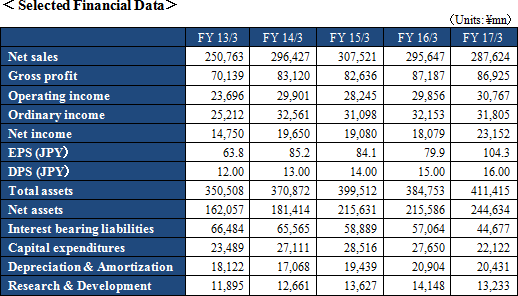 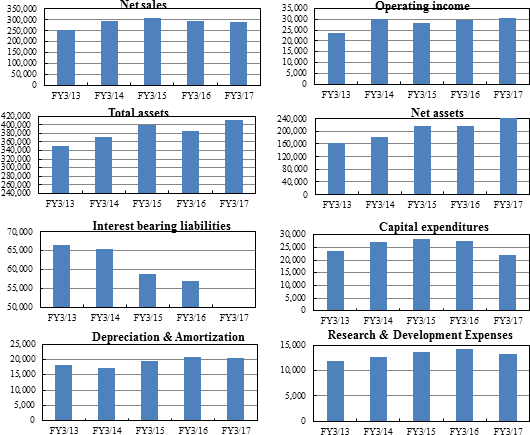 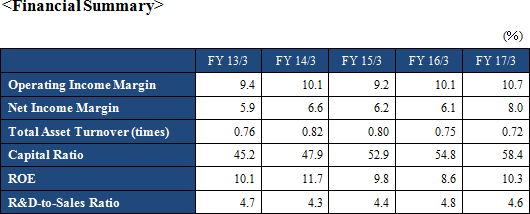    |


